Human resource management (HRM) is the strategic and coherent approach to the management of an organization’s most valued assets of the people working there who individually and collectively contribute to the achievement of the objectives of the business. The terms “human resource management” and “human resources” (HR) have largely replaced the term “personnel management” as a description of the processes involved in managing people in organizations. In simple words, HRM means employing people, developing their capacities, utilizing, maintaining and compensating their services in tune with the job and organizational requirement.
Human resource management (HRM) is based primarily on the assumption that employees are individuals with varying goals and needs, and as such should not be thought of as basic business resources, such as trucks and filing cabinets.… Read the rest


